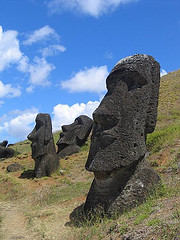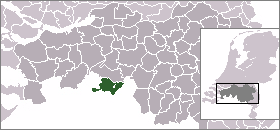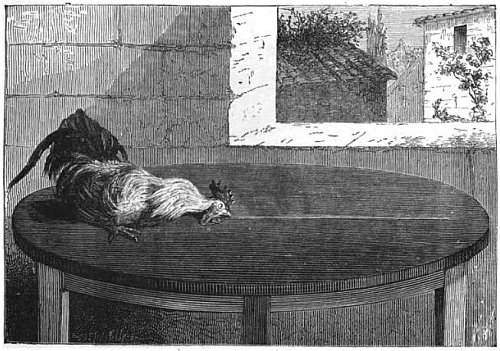In 1945, Betty Lou Oliver plunged 75 stories inside an elevator when a B-25 bomber struck the Empire State Building.
Fourteen people died in the plane crash, but Oliver survived.
In 1945, Betty Lou Oliver plunged 75 stories inside an elevator when a B-25 bomber struck the Empire State Building.
Fourteen people died in the plane crash, but Oliver survived.
Twelve percent of American 20-year-olds are left-handed, but only 5 percent of 50-year-olds and fewer than 1 percent of people over 80.
Does this mean that more lefties are being born today? Or that older generations were forced to switch hands? Or that southpaws die sooner? No one knows.

Statues aren’t the only mystery on Easter Island. Tablets found on the island bear a mysterious script, known as rongorongo, that has never been successfully deciphered.
Some scholars have pointed out similarities between the strange characters and the prehistoric script of the Indus Valley in India, 6,000 miles away, but others dispute this.
The islanders themselves give eager and varying accounts to archaeologists and historians, and perhaps they themselves don’t know. Some say that rongorongo means peace-peace, and that the documents record treaties, perhaps with visitors to the island.
So far, none of the attempts at translation have withstood peer review.

Wander too far away from the World’s Columbian Exposition of 1893 and you might disappear forever.
Herman Mudgett, an enterprising serial killer, built a row of three-story buildings near the Chicago fair and opened it as a hotel. Guests discovered — too late — that it was a maze of more than 100 windowless rooms, where Mudgett would trap them, torture them in a soundproof chamber, and then asphyxiate them with a custom-fitted gas line.
Then he’d send the bodies by chute to the basement, where he’d cremate them or sell them to a medical school.
This went on for three years, until a fire broke out and police and firemen discovered the trap. No one knows how many people Mudgett killed; he confessed to 27, but estimates go as high as 230.
He was hanged in Philadelphia in 1896.
In 1963, Peter Reyn-Bardt killed his wife and buried her in a peat bog in Cheshire County, England. Twenty years later, when a body was discovered, he assumed he’d been caught and turned himself in.
He should have waited. An investigation showed that the body was not his wife’s, but that of an Iron Age man who had died two thousand years earlier and been eerily preserved in the cold acid bog.
They convicted Reyn-Bardt anyway.
On the morning of Feb. 8, 1855, residents of Devon, England, awoke to find a series of prints in the snow. Resembling cloven hooves, the “devil’s footprints” ran through the countryside for more than 100 miles, largely along straight lines and seemingly unimpeded by rivers, haystacks and other obstacles.
Some attribute the prints to hopping mice, whose jumps can leave hooflike marks, but they’d have to be pretty ambitious mice — the tracks covered more than 100 miles, topping houses and high walls. On the other hand, no one has offered a better explanation.

Good luck delivering a letter in Baarle-Nassau. The Dutch municipality contains 24 Belgian exclaves — “islands” of Belgium “floating” in the Netherlands.
Worse, those islands contain islands: The 24 Belgian exclaves contain seven Dutch exclaves. Bring a map.

One can hypnotize a chicken by holding its head against the ground and drawing a line straight outward from its beak.
“I recollect particularly a case of catalepsy produced in a cock,” writes Gaston Tissandier in Popular Scientific Recreations (1882). “We place a cock on a table of dark colour, rest its beak on the surface, where it is firmly held, and with a piece of chalk slowly draw a white line in continuation from the beak, as shown in our engraving. If the crest is thick, it is necessary to draw it back, so that the animal may follow with his eyes the tracing of the line. When the line has reached a length of about two feet the cock has become cataleptic. He is absolutely motionless, his eyes are fixed, and he will remain from thirty to sixty seconds in the same posture in which he had at first only been held by force.”
Most chickens will stand immobile and stare at the line for about 30 minutes. The record, reported by Hamilton Bertie Gibson in Hypnosis: Its Nature and Therapeutic Uses (1980), is 3 hours 47 minutes.

Finders keepers.
These amber panels, backed with gold leaf and mirrors, once dressed an entire chamber in the Catherine Palace near Saint Petersburg. More than a decade in the making, they covered 55 square meters and contained more than six metric tons of amber. Some called them the eighth wonder of the world.
The Nazis took them during World War II, but after that they disappeared. Postwar rumors have put them in bunkers, in mines, in submarines, in lagoons. One stone mosaic turned up in 1997 in West Germany, and its fellows were found in Königsberg Castle, where the Nazis had secreted them. But the rest of the “Amber Room” has simply disappeared — lost in a fire, still hidden, or safe in the hands of a lucky, and quiet, treasure hunter.
In 1878, paleontologist Edward Drinker Cope discovered the partial vertebra of a new species of dinosaur near Morrison, Colo. It was in poor condition but enormous, 7.8 feet high.
If it really existed, that would make Amphicoelias fragillimus the largest dinosaur ever discovered, up to 200 feet long and weighing as much as 185 tons, the equivalent of a land-dwelling blue whale.
Cope packed up the vertebra and sent it by train to a New York museum, but apparently it crumbled into dust on the way. All that remain are Cope’s description and a line drawing. Oh well.